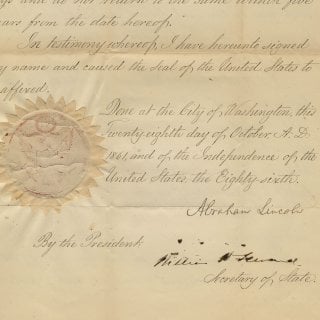A Generous President Abraham Lincoln Pardons a Young Man On One Condition: That He Leave the Nation’s Capital


A rare full pardon, signed in the first year of his Presidency by Lincoln and Secretary of State William Seward.
Lincoln’s clemency is central to his legacy. His stern leadership combined with a soft heart makes him more human and resolute at the same time. During Lincoln’s presidency, under his clemency powers, he pardoned 324 persons for crimes for which they had been convicted by civil courts. The standards of kindness and...
Lincoln’s clemency is central to his legacy. His stern leadership combined with a soft heart makes him more human and resolute at the same time. During Lincoln’s presidency, under his clemency powers, he pardoned 324 persons for crimes for which they had been convicted by civil courts. The standards of kindness and mercy that he used were no different than those for convictions in military courts. Attorney General Edward Bates’ pardon clerk later wrote of Bates that he discovered “his most important duty was to keep all but the most deserving cases from coming before the kind Mr. Lincoln at all; since there was nothing harder for him to do than to put aside a prisoner’s application and he could not resist it when it was urged by a pleading wife and a weeping child.”
Charles de Villier was a Frenchman an a native of Guadeloupe, and he and his father had come to the United States because, as he wrote in his pardon petition addressed to President Lincoln, of “international troubles by which they lost their property.” They were teaching “ancient and modern languages” to get by. “In a moment of derangement of mind,” wrote de Villiers in his pardon petition, “he bought articles to the amount of $25 under ‘false pretenses’, was arrested and plead guilty and was sentenced to imprisonment of 18 months.” “In his heart,” de Villiers went on to say, “he was not guilty but intended to pay for the goods when he received a remittance from New York.” He was sent to jail. The petition is found in the Lincoln Papers in the Library of Congress, along with a letter de Villiers wrote the trial judge asking for clemency. The petition was endorsed by ten well connected Washington, DC residents, among them chaplain H.S. Stevens, and notably, H.S. Johnston, the man from whom the goods had been taken.
Lincoln agreed to grant the pardon, but perhaps not buying de Villier’s story, had one caveat: that de Villier leave Washington for at least 5 years, and leave promptly.
Document signed, October 28, 1861, also signed by Secretary of State William Seward. “Whereas…Charles de Villier was indicted and convicted for obtaining goods under false pretenses, and was by said Court sentenced to be imprisoned in the Penitentiary for the period of 18 months; and whereas the said Charles de Villier has now served out more than 6 months of his said term of imprisonment…; And whereas it appears that this was his first offense…; and whereas a large number of highly respectable citizens of the District of Columbia have earnestly brought me to extend the Executive Clemency…; Now therefore let it be known that I Abraham Lincoln, President of the United States of America, in consideration of the promises, divers other good and sufficient reasons…do hereby grant unto him, the said Charles de Villier a full pardon on condition that he leave the District of Columbia within thirty days and do not return to the same within five years from the date hereof.”
Full pardons signed by Lincoln and Seward are increasingly uncommon.

Frame, Display, Preserve
Each frame is custom constructed, using only proper museum archival materials. This includes:The finest frames, tailored to match the document you have chosen. These can period style, antiqued, gilded, wood, etc. Fabric mats, including silk and satin, as well as museum mat board with hand painted bevels. Attachment of the document to the matting to ensure its protection. This "hinging" is done according to archival standards. Protective "glass," or Tru Vue Optium Acrylic glazing, which is shatter resistant, 99% UV protective, and anti-reflective. You benefit from our decades of experience in designing and creating beautiful, compelling, and protective framed historical documents.
Learn more about our Framing Services








































































































